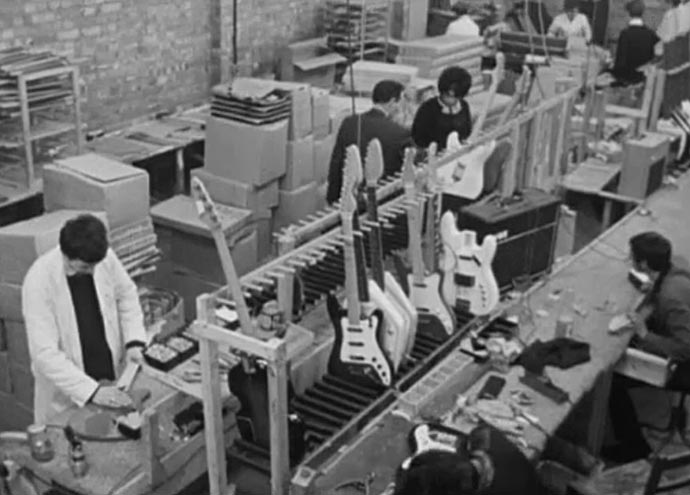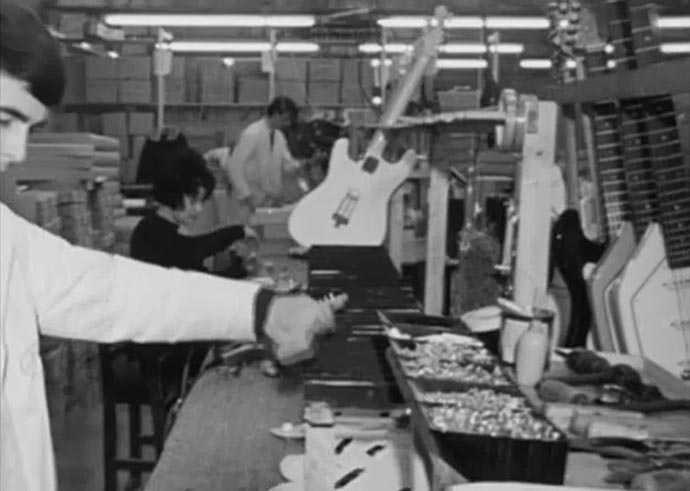
I received an email from Tony Russell in Western Australia, in December 2014, looking for parts for a Vox Ace he assembled himself whilst working in JMI's two plants making Vox guitars in Dartford, UK. Tony was kind enough to answer a few questions, and tell his story…
Like many kids of the post war era I finished school at the age of 15 with ambitions to be like the many up-and-coming rock and roll stars of that time. It was 1964. My father played a little guitar and my gran was an accomplished pianist, so I guess some of this rubbed off on a young, impressionable would-be, if he could-be. As it was, I did have a guitar at this time, it was a crappy acoustic which cost fifteen pounds; it was a piece of absolute junk, with strings about a half inch from the fret board. Dad brought me tickets to see the Shadows at the local Odeon theatre, from that moment on I was hooked on electric guitars, and Hank Marvin will always be my guitar hero. After a couple of low paid, low ambition jobs, I answered an ad in the local paper for guitar production makers at a place called Jennings Musical Industries in Dartford Kent. It was a turn up at factory to be interviewed on the day type of scenario. Although I had no idea how to make a guitar I applied anyway and got the job. I think I started at JMI in June 1965. I would have been 16 years of age. I started off at the Dartford Road plant, sweeping floors, and tidying the work stations of the guitar makers who were all young, and like me all wanted to be rock stars.
I loved this place, I was a small part of this enormous growing entertainment industry. I used to watch with fascination the guys making the guitars, and asked to be able to get more involved in this process, which was granted.

I seem to recall about 5 work stations, the final part was the fretting area which was at the far end of the assembly area. The factory was far bigger than shown in the film, the work station area would have been about 10 metres long, and then about 10 metres up to the fretting area. Around 10 staff were working on the guitar line altogether. To the left of this were test and new product development rooms, I think a lot of the staff used to catch a few winks in these out of bounds rooms! Soon I was screwing the necks of the guitars onto the bodies of the various models. I was working at my own work station, and it was at this station that you ate your lunch and had morning tea.
The amplifier section was off limit to us and filled about half of the building, however I used to have a bit of a look from time to time. I remember the Vox Foundation Bass amp with the enormous 18 inch speaker which would make your trousers flap if you stood in front of it when cranked up.
I was shown how to fret guitars and I became quite good at this; it was whatever guitar was being made that day, this would be dependent on what components had arrived to complete any given model, I could fret anything that was given to me, from memory about three of us could fret guitars. I fretted about 10 a day. I remember being given the fretting duties for a model called the Vox Soundcaster, which was the company’s high end model with three pickups, tremolo, and fancy fittings; with a price to match. It was supposed to be up against the Fender Strat, but fat chance of that, even though it was a good guitar with good quality timbers, reasonable pickups etc, it would never win that market segment.
A lot of the components came from Italy, necks etc, and I think a lot of the bodies came in unpainted and were painted at JMI, it’s all a bit foggy.

As I mentioned earlier we always ate our lunch at our work stations, and my Mum used to pack me banana sandwiches which I loved. Sadly, so did Bill Wyman of the Rolling Stones, who on several occasions would come in to JMI and, sit down next to me at my work station and share/pinch, my sandwiches, I distinctly remember him saying to me one day, before I could hide, did your Mum make you banana sandwiches today. Bugger!!
I have lost count of all the famous faces who came to visit JMI, most were there to pick up free amps and guitars as the publicity this gave the company after the groups used it on TV was priceless. It’s funny but these famous people of the day meant nothing to me, all I was interested in was my pay at the end of the week and keeping my hormones in control. However I can remember a few: Wayne Fontana, Burt Weedon, The Hollies, The Stones The Pretty Things, The Undertakers, and I was told that the Beatles had called in, but I cannot verify that.
I made the Ace at work. It was made from slightly damaged components, which we could take home. I still have it, it’s a bit battered but I will never sell it, as I made it in a time when music was music and you really did have to learn to play, which I still do, thankfully, at the age of 65. I also made a Symphonic bass from these reject bits, but have no idea what happened to it, sadly.
One day I was asked to assemble a Vox Phantom, not the tear drop model but the model with the body angles. I found out it was supposedly going to Rolling Stones. I cheekily put my initials under the scratch plate on the wood. I guess there would be a fair few with these weird initials inside and people trying to make out who this strange person may have been. Another time I was called into the bosses office and was presented with a box of components to make a Vox Soundcaster. Unusually, all the hardware was gold plated and the tremolo knob was in ivory, all very flash, I asked who it was for but was told to mind my own business, and to just get on with it and make it perfectly, which I did. When it was finished, which took two days, it went into the flashiest guitar case I had ever seen. Two weeks later I was again called into the bosses office and he said to me, and I quote, ‘when you leave the factory tonight if there are any members of the press outside and you talk to them you are fired’. I was shocked and upset, not knowing what the hell I had done, which of course was nothing. Several months later, at our Christmas booze up I asked the boss who the guitar was for; as he had had a few drinks he capitulated and said it was for Prince Charles; the company was trying to get the Royal Charter symbol on their products. I wrote to Prince Charles in the 1980’s to enquire what had happened to the guitar and the palace wrote back, very interested in its history, but would not comment further. I still have that letter, and cherish it. The guitar is probably safe under one of the royal beds, after Charlie found out after one practice lesson that steel strings can make the royal fingers sore!!
Another product I helped with the development of was the first 5 string bass guitar made in England [actually just after the US-built Fender Bass V was launched in 1965, although these were probably not yet available in the UK] It was made for the bass player of the Hollies at the West Street factory, that we moved to. I put the components together, and then strung it. I had nothing to do with the electrics or the testing, I remember that it looked like a standard Symphonic bass, just with five strings. It was a dark sunburst in colour. I remember playing it through a small amp and everybody thinking it was far too revolutionary for the time. The biggest issue with it was the gauge of the strings for the bottom end. Rotosound would have made these locally at their Blackfen factory. This was another company on the cutting edge of music development; Vox products were being used all over the world and the place was pumping, but Rotosound made me an offer I could not refuse and I went to work for the Howe family and became a string maker, and I loved this work as well.
$1250
$1400
$1600
$4200
$1000
$450
$120
$2800
$650
$499
$714
$50
$2800
$1090
$4499
$650
$3000
$795
$1899